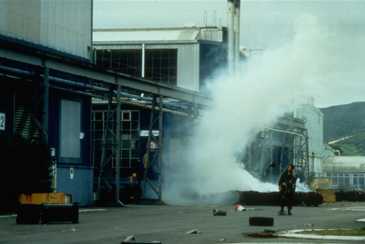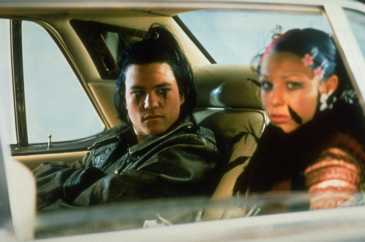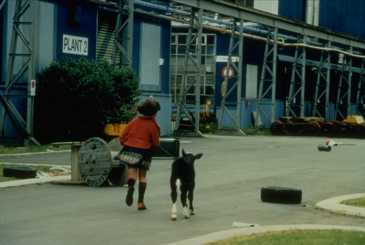 It’s the year 2080. Homer Simpson is gone, the Springfield Power Station has closed down – there are no TVs to power The Simpson’s antics. The Earth is covered in a green glowing substance. Lakes and rivers bubble radioactive material. There are no green trees, no animals, no adults and no children. It is strangely quiet. Is this the new virus?
It’s the year 2080. Homer Simpson is gone, the Springfield Power Station has closed down – there are no TVs to power The Simpson’s antics. The Earth is covered in a green glowing substance. Lakes and rivers bubble radioactive material. There are no green trees, no animals, no adults and no children. It is strangely quiet. Is this the new virus?
No! This is what could happen to our world if we don’t come up with a safer way to take care of hazardous waste. In the world of recycling something that is dangerous to the environment is hazardous waste. Hazardous waste can be harmful to people, animals and plants by being poisonous or toxic – it can make you sick or even kill you! Nuclear waste is the by-product of nuclear power and is a form of very dangerous hazardous waste in it’s own right.
In simple terms, nuclear waste comes from the many nuclear power plants around the world when they complete a process called nuclear fission. Fission occurs when uranium atoms are split into small atoms. This creates a huge amount of energy, and this energy is used to make electricity. This process happens (inside the power plant) in big metal rods called fuel rods. Once every couple of years these rods need replacing – but the fission process leaves behind radioactive material. This is called nuclear waste. These rods have got to go somewhere at the end of the process… but where is safe to get rid of something that is hazardous to us?
Nuclear waste disposal is a very touchy and worrying issue, despite all the jokes you see about it on the Simpsons! Homer just wouldn’t be able to throw that green rod out the window and get away with nothing seriously wrong happening! In the United States alone there are over 100 nuclear power plants… and these plants generate more than twenty percent of America’s electricity very efficiently. But so far there has been no safe, permanent way of disposing of waste that comes from this production, and others like it around the world. And that is why it is a tricky issue – there is a high cost to the Earth from the benefits received when electricity is produced in such an effective way. Because of this we are seeing more and more nuclear plants closing down as people realise that the cost to the environment is not worth the savings being made now. But there is still a lot of outstanding waste that will not just go away.
 Since the first power stations started popping up over thirty years ago, nuclear waste has been held securely in storage facilities. But this is not permanent, nor is it a very safe way of keeping that waste from causing havoc to the world.
Since the first power stations started popping up over thirty years ago, nuclear waste has been held securely in storage facilities. But this is not permanent, nor is it a very safe way of keeping that waste from causing havoc to the world.
But coming up with a better solution is very tricky too. To start with, nuclear waste is very hard to handle – one slip up and there is big trouble. Scientists are faced with the problem of how to transport the waste safely and how to treat or store it in ways that do not allow the waste to escape or spread. In addition, as more and more power plants start up business there is more and more waste – and once the waste has been stored away in the facility you can not just open up the box and throw some more in!
And on top of that, the types of nuclear waste can be very different and disastrous if mixed up together.
And from our own perspective: who wants to have nuclear waste dumped in our own back yard? There is a lot of pressure on scientists to find a permanent method of disposal, one that does not sit festering for years and years, always causing the worry that one day something bad might happen. Nuclear waste is invisible which means you may not know that it is around until it is too late. And the effects of the radioactive materials are long term (they can last for thousands of years), so the idea of them escaping can be very scary.
One new idea has been tested by the US Department of Energy. The department’s goal is to come up with a safe way of getting rid of new nuclear waste, as well as clearing the backlog of the old stuff. The department is using a machine to separate nuclear waste into its core components, some of which are not hazardous and therefore reducing the overall amount of left over harmful waste, which is then buried in secure containers. These containers have appeared to be resistant against all the natural disasters that you can think of – flooding, earthquake, fire etc. But the results of these tests are still a long way off, so we still don’t know if we have found an effective disposal method. However, the Department of Energy is very careful with their handling of nuclear waste, and because of this there is a lower chance of things going wrong.
Hopefully the future will reveal more ways to break down this hazardous nuclear waste. In the meantime, new generations need to steer away from creating more nuclear waste and by voicing their opinion that action needs to be taken… so we don’t have our beautiful world taken away from us.
 Hazardous Waste in The Tribe
Hazardous Waste in The Tribe
When the adults died so did any form of factory or plant. There was no one to take over so these factories just ceased to produce anything. But there could still be hazardous materials from the factories around and so far in The Tribe we haven’t come across it.
When the Techno’s moved in to the city they brought electricity. The type of electricity they were producing was from coal which is a natural substance, a fossil fuel, and less likely to cause any hazardous waste.
A question that is often asked by fans of The Tribe is “where do the kids go to the toilet?” We don’t know the exact answer to that as it hasn’t been covered in the programme. The kids would have to go back to basics as they have with everything else in their lives. With no flushing toilets that take the waste away they would probably have to dig holes to go in. Not the most pleasant thought!
But the Techno’s set up running water didn’t they? Doesn’t this mean the toilet’s would work?
Sure they might flush but with no one running a Waste Treatment Plant or maintaining the sewer system there could be big problems!
The streets of the city in Tribeworld are littered with rubbish but surprisingly it could be worse. Everyone has to recycle to live, clothe themselves, and trade so although there is paper flying around it’s biodegradable and will soon turn to mulch. Plastic is not very biodegradable and can stay around for years.
The kids of Tribeworld need to think of their future – they’re already trying to build a new world but there are so many issues that face them and waste is just one of them.

